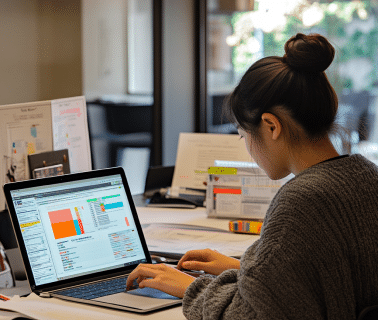When studying economics at the degree level, students often need help understanding the basic difference between two topics. These are Microeconomics and Macroeconomics. Economics is often referred to as the study of informed decision-making for the efficient allocation of resources among individuals and organizations. The subject is often divided into microeconomics and macroeconomics, each covering different concepts that help students analyze global economic activities. In this blog, we attempt to draw a comparison between Microeconomics vs. Macroeconomics for the general understanding of students aspiring for an MA in Economics.
What is Microeconomics?
Let us begin the comparison of Microeconomics vs. Macroeconomics by defining Microeconomics first. In simple words, the study of Microeconomics focuses on the small and individual components of an economy. It studies in detail the decisions that individuals, business organizations, and households make in allocating resources in a market economy.
Some key topics are covered in the basics of micro and macroeconomics. Microeconomics studies include pricing, costs involved in production, demand and supply, and customer behavior. For instance, studying how a business enterprise sets the price or cost of its goods is covered in Microeconomics. So is the decision-making process followed by customers or the end user in spending their money or saving it.
What is Macroeconomics?
Continuing with the Microeconomics vs. Macroeconomics debate, let us take a closer look at the meaning of Macroeconomics. Contrary to Micro, Macroeconomics refers to the study of the economy as a whole. It takes into account the interaction of large-scale economic factors and their overall impact on the economy. In other words, Macroeconomics deals with aggregate indicators, covering topics such as inflation, fiscal policy, GDP, unemployment, and international trade in its study.
For instance, Macroeconomics would cover an analysis of the growth rate of the whole economy. It would also analyze the various economic policies in place to help manage unemployment or inflation in the country, for instance.
Key Difference Between Microeconomics & Macroeconomics
We looked at the definitions of both the terms for a better understanding. Let us now look at the key difference between Micro and Macroeconomics that sets the two apart.
| Parameters | Microeconomics | Macroeconomics |
|---|---|---|
| Scope | Prime focus on individuals and factors like product pricing, demand, supply, production, and consumption | Focus on the economy as a whole and covers national income, unemployment, general level of price, etc. |
| Objective | Effective allocation of resources in a particular market section of the economy | Overall growth and economic stability, covering several segments of the market |
| Analysis Units | Specific entities or markets | Aggregated data such as national income, unemployment, GDP |
| Business Application | Internal issues within the business | Applies to external and environmental issues |
| Importance | Helps regulate the pricing of a product along with prices of other production factors, such as land, capital, labor, and entrepreneur within the economy | Helps deal with major economic issues like inflation, deflation, reflation, poverty, or unemployment |
| Challenges | Based on certain unrealistic assumptions, such as the presupposition of complete employment in the community | What may be true for aggregate or the overall economy may not always be entirely accurate for all individuals as well |
How Micro and Macro Complement Each Other
We learned the key differences between Micro and Macroeconomics in the above section. However, both these studies also complement each other and it is therefore important to understand both to obtain a holistic view of economics.
Decisions taken at the micro-level (individual level) generally have a considerable impact on macroeconomic outcomes. For instance, the decision of many individual businesses across varied industries to raise prices simultaneously may contribute to overall inflation in the economy.
Likewise, macroeconomic policies can impact microeconomic conditions in the environment. For example, the rates of interest in the economy have a considerable effect on individual borrowing trends. Alternatively, an analysis of microeconomics serves as the foundation for macro analysis. We are able to better understand how individual behavior and decisions add up to create broader economic trends in the country.
Applications in Real Life
We have learned the theoretical concepts of both micro and macroeconomics. Interestingly, the basics of micro and macroeconomics can be applied in real-life situations too. Here are some examples for both:
Applications of Microeconomics
- Pricing strategies for businesses: Several business organizations use principles of microeconomics to identify the best pricing strategies for boosting profit and revenue. For instance, during the festive season, many popular electronic brands lower the prices of their popular products, since demand during this time is highly elastic. This generally tends to increase sales, thus maximizing revenue.
- Household budget planning: Households generally run on a monthly budget and this is a classic example of effective allocation of scarce resources. The principles of microeconomics can be used here to determine how to allocate the limited income to meet competing requirements of food, kids’ education, transport, and entertainment.
Macroeconomics Applications
- Managing economic crises: In the case of a large-scale national economic crisis, policymakers use macroeconomic tools and measures to manage the crisis effectively. For instance, during the COVID-19 economic crisis, lockdowns resulted in huge job losses for several people, and businesses also closed down.
The government offered unemployment benefits and the central banks offered liquidity through reduced interest rates. Additionally, trade efforts were made to ensure the smooth flow of essential goods like medical supplies to the public.
- Developing government policies for growth: These include introducing monetary policies such as the management of interest rates collectively to lower the cost of borrowing by individuals. Also, fostering domestic production of goods to lower dependency on imports is a strategic trade policy by the government.
Check out how repo rate of Reserve Bank of India impact on the lives of citizens.
Conclusion
In this blog, we learned the vast scope of micro and macroeconomics and why it is essential to understand both. Both these branches of study in economics offered valued insights into various aspects of the economy. It aids individuals, businesses, and governments in making informed decisions for the betterment of all.
To further better understand the scope of micro and macroeconomics in detail, pursue an online MA in Economics degree from Manipal University Jaipur (MUJ). The degree is an effort at acquainting learners with the basics of micro and macroeconomics. Also, learn their application in everyday work environments and receive complete professional assistance in placements. MUJ offers all this and much more through its online MA in Economics degree offered on the Online Manipal platform.
Prepare for your next career milestone with us


















